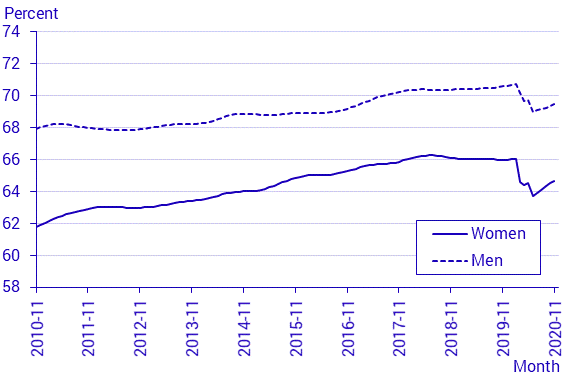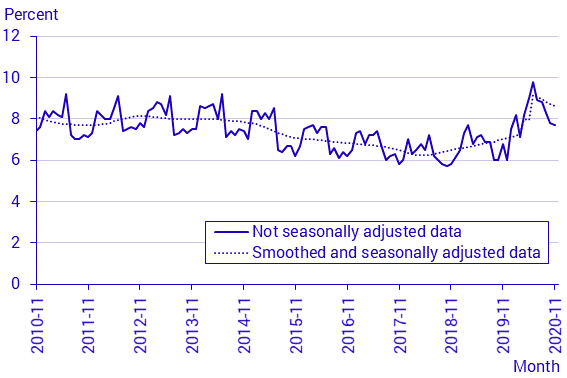Labour Force Surveys (LFS), November 2020
Labour market remains subdued
Statistical news from Statistics Sweden 2020-12-17 9.30
In November 2020, there were 5 062 000 employed people, non seasonally adjusted, which is 78 000 fewer than in November 2019. The decrease occurred among young persons aged 15-24 years. The number of unemployed people was 421 000 and the unemployment rate was 7.7 percent, up by 0.9 percentage points. The average number of hours worked was 168.3 million hours per week, which corresponds to a decrease of 3.9 percent, calendar-adjusted. Seasonally adjusted and smoothed data has not shown any detrimental changes to employment or unemployment since June. The unemployment rate was 8.6 percent.
The change in the number of unemployed persons and the unemployment rate between November 2019 and November 2020 may be somewhat underestimated. This may be due, in part, to the fact that unemployment appears to have been somewhat overestimated in November 2019 and somewhat underestimated in November 2020. The distribution among non-respondents might explain the possible underestimation in unemployment this month.
The labour force
In November 2020, there were 5 483 000 people aged 15–74 years in the labour force, not seasonally adjusted. There were 2 879 000 men and 2 604 000 women in the labour force. The relative labour force participation rate was 72.7 percent. Among women this rate was 70.3 percent and among men the rate was 75.0 percent. There were 523 000 young people aged 15–24 years in the labour force, a decrease of 84 000 compared with the same month the previous year. The relative labour force participation rate for young people was 45.3 percent, down by 7.2 percentage points.
According to seasonally adjusted and smoothed data, there were 5 536 000 people in the labour force. The labour force participation rate was 73.4 percent, which is similar to the level in February, when the effects of COVID-19 were not yet discernible in the Swedish labour market. The lowest recorded levels for both the number of people in the labour force and the labour force participation rate were noted in March.
Employment
In November 2020, there were 5 062 000 employed people aged 15–74 years, not seasonally adjusted, which is 78 000 fewer than in the same month a year ago. There were 2 403 000 employed women and 2 659 000 employed men. The employment rate decreased by 1.2 percentage points and amounted to 67.1 percent. For women the rate was 64.9 percent and for men the rate was 69.3 percent. There were 419 000 employed young people aged 15–24 years, a decrease of 79 000 persons, and the employment rate among young people was 36.3 percent, which corresponds to a decrease of 6.8 percentage points.
According to seasonally adjusted and smoothed data, there were 5 060 000 employed people. This is a decrease of 94 000 people, of whom 55 000 were young people, compared with February 2020, when the effects of COVID-19 were not yet discernible in the Swedish labour market. The employment rate was 67.1 percent, which is 1.3 percentage points less than in February 2020. However, seasonally adjusted and smoothed data shows an increase in employment since the lowest recorded figure in June.
Employees
In November 2020, there were 4 568 000 employees, according to non-seasonally adjusted data. This is 122 000 fewer than in the corresponding month last year. Among women the number of employees was 2 273 000. Among men there were 2 295 000 employees, which is a decrease of 70 000. There were 3 893 000 permanent employees and 675 000 temporary employees. The number of temporary employees decreased by 107 000 persons compared with the same month the previous year.
Compared with February 2020, seasonally adjusted and smoothed data shows a decrease of 82 000 employees, of whom 75 000 were temporary employees. As with the employment rate, there has been an increase in the number of employees compared with June, when the lowest figure was noted.
Hours worked
In November 2020, the average number of hours worked was 168.3 million per week, not seasonally adjusted. In calendar-adjusted figures, this corresponds to a decrease of 3.9 percent compared with the corresponding month a year ago. In the industry hotel and restaurants the number of hours worked decreased by 20.0 percent, calendar adjusted, compared with November 2019.
Seasonally adjusted and smoothed data shows that the average number of hours worked per week was 149.5 million, which is 7.0 million hours per week less than in February 2020. In 2020, the lowest recorded figure of number of hours worked per week was noted in April; this figure has since increased by 9.9 million hours.
In work and absence
There were 4 601 000 people employed and in work in November 2020, not seasonally adjusted. Calendar-adjusted, this corresponds to a decrease of 2.6 percent compared with the same month a year ago.
The LFS estimates the number of people who were absent from their principal occupation for the whole week or for part of the week by main reason for absence. In November 2020, this figure was 1 165 000. There were 466 000 people absent for the whole week in November 2020, not seasonally adjusted. Among these, 175 000 were absent due to illness, while 29 000 were absent for the whole week due to lack of work. There were 37 000 people absent due to holidays.
People who are absent due to lack of work or lay-offs are often absent for only part of the week. There were 87 000 people in total absent for the whole week or part of the week due to lay-offs. There were 73 000 people who stated lack of work as their main reason for absence.
Seasonally adjusted and smoothed data showed that there were 4 272 000 people in work, which is 114 000 fewer than in February 2020. There were 788 000 people absent for the entire week. In 2020, the lowest recorded figure of the number of employed people in work was noted in April. Since April, this figure has increased by 186 000 people.
Unemployment
In November 2020, there were 421 000 unemployed people aged 15–74 years, not seasonally adjusted. This corresponds to an unemployment rate of 7.7 percent, which is an increase of 0.9 percentage points compared with the same month a year ago. The number of unemployed women was 201 000 and the number of unemployed men was 220 000. Among women the unemployment rate was 7.7 percent and among men it was 7.6 percent. There were 104 000 unemployed young people aged 15–24 years, which corresponds to a youth unemployment of 19.9 percent.
Among people aged 15-74 years, seasonally adjusted and smoothed data shows an increase of 78 000 unemployed people, and an increase of 1.4 percentage points in the unemployment rate compared with February 2020. In November 2020, there were 476 000 unemployed people, which corresponds to an unemployment rate of 8.6 percent. According to seasonally adjusted and smoothed data, the highest level of unemployment in 2020 was noted in June. Among young people aged 15–24 years, seasonally adjusted and smoothed data shows an increase in both the number and proportion of unemployed people compared with February 2020. The number of unemployed young people increased by 14 000 to 143 000, and the unemployment rate increased by 3.9 percentage points to 24.4 percent.
Additional questions on the impact of COVID-19 on the labour market
In view of the coronavirus (COVID-19) pandemic, questions about the impact of COVID-19 have been added to the LFS. The answers to these questions show that 125 000 employed people aged 15–74 years were absent during the whole reference week in November related to COVID-19. This means that among people who were absent during the entire reference week, 27.2 percent were absent due to COVID-19. This proportion was 31.0 percent for men and 24.2 percent for women.
Among employees aged 15–74 years who were absent during the entire reference week, 24.0 percent, which corresponds to 98 000 people, stated that their absence was related to COVID-19. This proportion was 26.8 percent for men and 22.2 percent for women. Furthermore, 37.9 percent of employees who were absent during part of the week, 225 000 people, stated that their absence was related to COVID-19. Among self-employed persons and assisting household members aged 15–74 years, 42.7 percent felt that they had less work due to the coronavirus pandemic, while 15.1 percent felt that they had more work.
To be classified as unemployed in the LFS, a person must be without a job, must be able to start work and must have sought work. This means that people who are without a job, but who have not been seeking work or are unable to start work are not classified as unemployed, but are classified, instead, as not in the labour force. In November 2020, there were 2 059 000 people aged 15–74 years outside the labour force. Among these, 82 000 people stated that they would have been able to work, but had not sought work due to COVID-19. In addition, 21 000 persons stated that they would not have been able to start their job due to COVID-19.




Next publishing will be
2021-01-28 at 9:30.
Feel free to use the facts from this statistical news but remember to state Source: Statistics Sweden.
